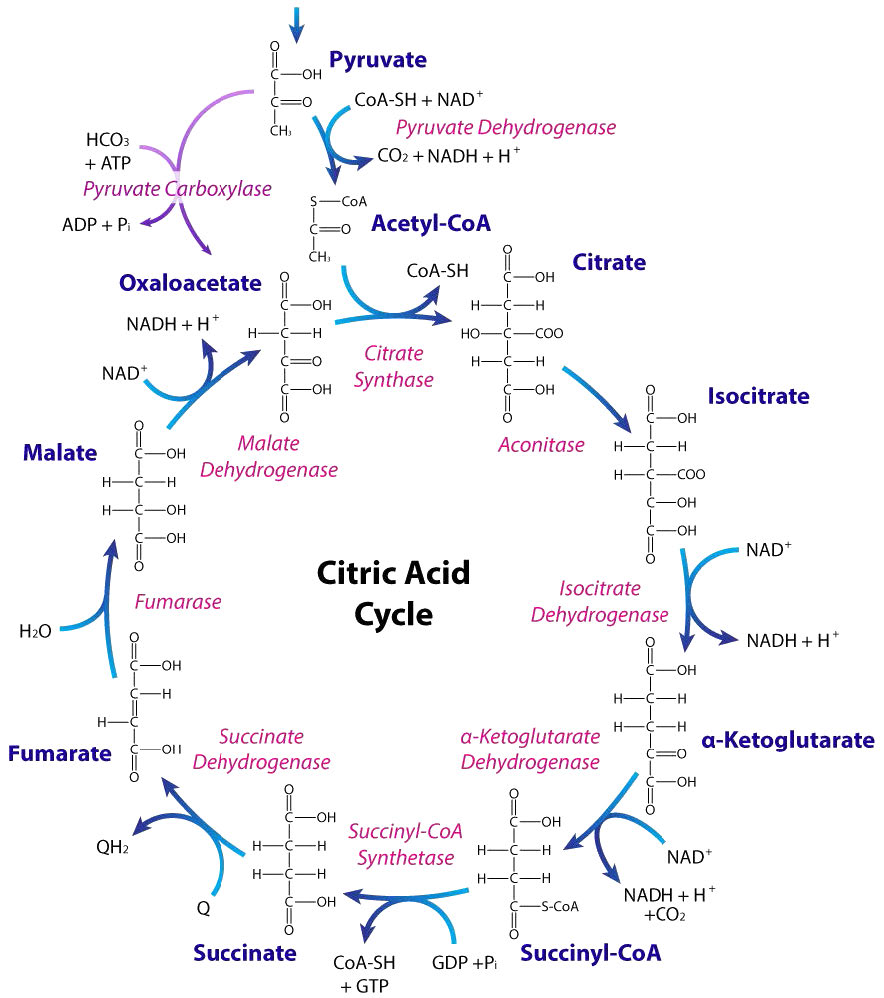
The intermediates of Krebs cycle forms
(a) Nucleotides
(b) Amino acids
(c) Cytochrome
(d) All of the above
Answer
582.3k+ views
Hint: In the citric acid cycle all the intermediates (e.g. citrate, iso-citrate, alpha-ketoglutarate, succinate, fumarate, malate, and oxaloacetate) are regenerated during each turn of the cycle.
Complete answer:Krebs cycle is also known as Citric Acid Cycle or Tricarboxylic Acid Cycle. It is used to oxidize the pyruvate formed during the glycolysis into carbon dioxide and water. It also oxidizes acetyl CoA which arises from breakdown of carbohydrate, lipid, and protein.Intermediate compounds formed during Krebs cycle are used for the synthesis of amino acids, nucleotides, chlorophyll, cytochromes and fats.
Oxaloacetate forms aspartate and asparagine amino acids. Alpha-ketoglutarate forms glutamine, proline and arginine amino acids.
Amino acids aspartate and glutamine are used to form the purines. Amino acid aspartate is used to form the pyrimidines. Intermediate succinyl CoA forms chlorophyll and cytochromes.
So,the correct answer is 'All of the above’
Note: The cycle of citric acid is a key metabolic pathway which connects the metabolism of carbohydrates , fats and proteins. The cycle reactions are carried out of two molecules each of carbon dioxide and water by eight enzymes that fully oxidize acetate (a two carbon molecule), in the form of acetyl-CoA.

Complete answer:Krebs cycle is also known as Citric Acid Cycle or Tricarboxylic Acid Cycle. It is used to oxidize the pyruvate formed during the glycolysis into carbon dioxide and water. It also oxidizes acetyl CoA which arises from breakdown of carbohydrate, lipid, and protein.Intermediate compounds formed during Krebs cycle are used for the synthesis of amino acids, nucleotides, chlorophyll, cytochromes and fats.
Oxaloacetate forms aspartate and asparagine amino acids. Alpha-ketoglutarate forms glutamine, proline and arginine amino acids.
Amino acids aspartate and glutamine are used to form the purines. Amino acid aspartate is used to form the pyrimidines. Intermediate succinyl CoA forms chlorophyll and cytochromes.
So,the correct answer is 'All of the above’
Note: The cycle of citric acid is a key metabolic pathway which connects the metabolism of carbohydrates , fats and proteins. The cycle reactions are carried out of two molecules each of carbon dioxide and water by eight enzymes that fully oxidize acetate (a two carbon molecule), in the form of acetyl-CoA.

Recently Updated Pages
Master Class 12 English: Engaging Questions & Answers for Success

Master Class 12 Business Studies: Engaging Questions & Answers for Success

Master Class 12 Economics: Engaging Questions & Answers for Success

Master Class 12 Social Science: Engaging Questions & Answers for Success

Master Class 12 Maths: Engaging Questions & Answers for Success

Master Class 12 Chemistry: Engaging Questions & Answers for Success

Trending doubts
What are the major means of transport Explain each class 12 social science CBSE

Which are the Top 10 Largest Countries of the World?

Draw a labelled sketch of the human eye class 12 physics CBSE

Explain sex determination in humans with line diag class 12 biology CBSE

The pH of the pancreatic juice is A 64 B 86 C 120 D class 12 biology CBSE

Explain sex determination in humans with the help of class 12 biology CBSE




